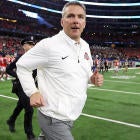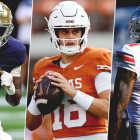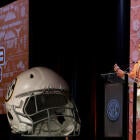The 2018 preseason edition of the AP Top 25 was released on Monday, and this is big news for a couple of reasons. The biggest of which is that the release of the preseason AP Top 25 means that the season is almost here. Seriously, there will be games played in anger on Saturday. This Saturday!
Another reason they are important is that, even if they're based on estimations and predictions, preseason polls aren't truly meaningless. They set the expectation for teams all across the country, and they're the basis for how teams are judged. If you aren't ranked to start the season, it's going to be difficult to reach the College Football Playoff this season no matter how well you perform. This is because, whether we're aware of it or not, preconceived notions about teams are extremely difficult to overcome in a sport with so many teams and so few games for each of them to play.
If you don't believe me, ask UCF about the perception battle it faced all last season. In fact, in the short history of the CFP, the lowest-ranked team in the preseason AP Top 25 to reach the playoff was Oklahoma in 2015. It began the season at No. 19. Last season, Georgia started the year at No. 15 before making its climb.
So preseason polls matter, whether we believe or want them to. And after going over this year's preseason AP Top 25 (you can see the entire thing right here), here are my thoughts on it.
1. The Ohio State Conundrum: One of the things I was very interested in tracking was how the AP voters would treat Ohio State in comparison to the Coaches Poll. The Coaches Poll votes were in well before the revelations about Ohio State receivers coach Zach Smith and Urban Meyer's leave of absence, and the Buckeyes were ranked No. 3 in the poll. With the current cloud hanging over OSU, I knew it would drop, and they it just that.
Ohio State opens the 2018 season ranked No. 5 in the AP Top 25, making it the second-highest ranked team in the Big Ten behind Wisconsin at No. 4. I do not envy the AP voters who had to figure out what to do with Ohio State. I was asked to submit my predictions for the Big Ten last week, and I just stared at the Big Ten East with no idea what to do.
Whether Meyer is fired, suspended or neither, it's hard to believe this situation won't have some kind of adverse effect on the season, but at the end of the day it's still one of the most talented teams in the country, so voters don't want to knock it down too far.
2. We're all too critical of Oklahoma: The Sooners are at No. 7 in the AP Top 25, two spots lower than their No. 5 position in the Coaches. I completely understand the reasoning behind it, but I can't help but believe we're all a bit guilty of underestimating the team that's likely going to remain the best team in the Big 12. I mean, at this point I have fewer questions about Oklahoma than I do Ohio State.
3. West Virginia is the team everyone talks themselves into: West Virginia is at No. 17 in the AP Top 25 and No. 20 in the Coaches Poll. While I haven't conducted an official poll this offseason, I'd estimate that roughly 80 percent of the college football media populace is listing West Virginia as its sleeper this year, and I fully understand why. The Big 12 is open after Oklahoma. The Mountaineers have a legitimate Heisman candidate in Will Grier, and he has a major weapon in David Sills V.
Where I divert from the majority of my colleagues, however, is that West Virginia had these things last season. Grier threw for 3,490 yards and 34 touchdowns in just over 10 games (he was injured in the eleventh against Texas). Sills caught 18 touchdowns. West Virginia scored 34.5 points per game.
And guess what? It finished 7-6 overall, though it was 7-3 in games Grier started and finished. But this team's problem was a defense that allowed 31.5 points per game (34.7 ppg in the Big 12), and I don't know what's changed on that side of the ball. I'm not saying the Mountaineers are incapable of having a strong season -- they could win 10 games -- but I'm taking more of a wait and see approach on them.
4. The Big Ten East is everybody's favorite division: The Big Ten has five teams ranked in the AP Top 25, just as many as the SEC does. Of those five teams, though, four of them reside in the Big Ten East and none of them are ranked lower than Michigan at No. 14. This is great for the Big Ten's overall reputation, but I wonder how beneficial it is to the conference as a whole. After all, the East being such a gauntlet last year is the main reason the conference missed out on a playoff berth.
5. Nobody likes Group of Five teams in the preseason: The highest-ranked such team is UCF at No. 21. Boise State is at No. 22. This is usually how things go. Group of Five teams have to prove themselves over the course of the entire season, while Power Five teams that are likely to finish in fourth or fifth in their conference are routinely ranked ahead of them to begin the season.
Last year, the only Group of Five team in the preseason AP Top 25 was South Florida at No. 19. In 2016, we saw Houston at No. 15, but it had to go 13-1 the year before and beat Florida State to get there. Had Scott Frost remained at UCF, I'd bet we'd see it higher than No. 21 at the moment, but not too much higher.
![[object Object] Logo](https://sportshub.cbsistatic.com/i/2020/04/22/e9ceb731-8b3f-4c60-98fe-090ab66a2997/screen-shot-2020-04-22-at-11-04-56-am.png)

















